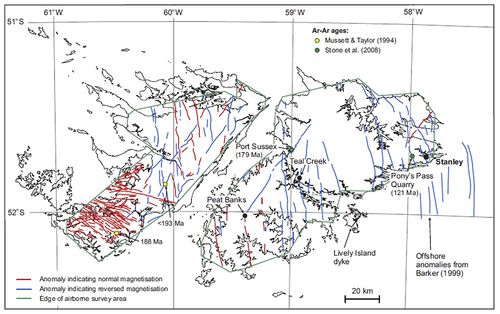OR/14/040 Mesozoic minor intrusions
| Stone, P. 2014. Recent contributions on Falkland Islands bedrock geology, with an inventory of representative lithostratigraphical specimens held by the British Geological Survey. British Geological Survey Internal Report, OR/14/040. |
A radical reinterpretation of the Falkland Islands dolerite dyke swarms was precipitated by an aeromagnetic survey flown in support of onshore mineral prospecting work. The results have allowed an improved discrimination of the principal swarms (Figure 9) and were augmented by radiometric dates and geochemical analyses of representative specimens. Most of the dykes previously described as forming a “north–south” swarm of Jurassic age are associated with a set of NE–SW linear magnetic anomalies that are entirely separate from another set of N–S to NNW–SSE anomalies. The NE–SW Jurassic dyke swarm occurs mostly in West Falkland but extends sparsely into East Falkland; a separate E–W dyke swarm, also of Jurassic age, is restricted to the southern part of West Falkland. The newly discovered N–S swarm spans West and East Falkland, and the offshore area to the south-east and has proved to be Early Cretaceous in age (Stone and others 2008; Richards and others 2013). The different dyke swarms, whilst all being broadly doleritic, are petrographically and geochemically distinct with, in particular, the Cretaceous dykes having a much higher Fe content than the Jurassic dykes. Ar-Ar age dating of East Falkland dykes has confirmed an Early Jurassic, ca 184–178 Ma, age for the NE–SW swarm, and has provided Early Cretaceous ages for the N–S orientated dyke swarm ranging from ca 135 Ma (Valanginian-Hauterivian) at Teal Creek and Peat Banks (Figure 9) to ca 121 Ma (Aptian) at Pony’s Pass Quarry; although it appears to be technically robust, on regional grounds the validity of the Aptian age at Pony’s Pass may be questionable (Richards and others 2013)[1].

It has also been possible to suggest correlations between the onshore dyke swarms and evidence for magmatism in the offshore Falkland Plateau basin (Richards and others 2013)[1]. The onshore Jurassic dykes, and a possible correlative dolerite body forming seismic basement in the Falkland Plateau Basin, are associated with the regional Karoo-Ferrar magmatism, linked to the initial break-up of Gondwana. The Early Cretaceous onshore magmatism has the same age as that assigned from seismic interpretation to sills and/or lavas within the Falkland Plateau Basin sedimentary succession. Both the onshore and offshore Early Cretaceous magmatism is likely to be associated with the later extension phases of the Falklands Plateau and rifting of the North Falklands Basin as the South Atlantic Ocean initially opened.
Hodgkinson (2002)[3] had questioned the validity of palaeomagnetic results from the dykes, and hence their use in support of a rotational model of a Falklands microplate. Nevertheless, an assessment of the asymmetry of the linear aeromagnetic anomalies associated with individual dykes (Stone and others 2009)[2] supported the rotational model of a Falklands microplate. There is a contrast between the anomalies associated with the Jurassic dykes and those associated with the Cretaceous dykes that is best explained by the former having experienced a pre-Cretaceous, clockwise microplate rotation of about 120º. The Cretaceous dykes and the NW–SE Jurassic dykes show both normal and reversed magnetic polarity, the E–W Jurassic dykes have consistently normal polarity (Figure 9).
Details of representative dyke specimens held by the British Geological Survey have been provided by Stone (2013)[4].
References
- ↑ 1.0 1.1 RICHARDS, P C, STONE, P, KIMBELL, G S, MCINTOSH, W C, and PHILLIPS, E R. 2013. Mesozoic magmatism in the Falkland Islands (South Atlantic) and their offshore sedimentary basins.Journal of Petroleum Geology, Vol. 36, 61–74.
- ↑ 2.0 2.1 STONE, P, KIMBELL, G S, and RICHARDS, P C. 2009. Rotation of the Falklands microplate reassessed after recognition of discrete Jurassic and Cretaceous dyke swarms. Petroleum Geoscience, Vol. 15, 279–287.
- ↑ HODGKINSON, R. 2002. Structural studies in the Falkland Islands, South Atlantic. Unpublished PhD thesis, University of Birmingham.
- ↑ STONE, P. 2013. Mesozoic dyke swarms of the Falkland Islands (South Atlantic). British Geological Survey Open Report, OR/13/026. 11pp.